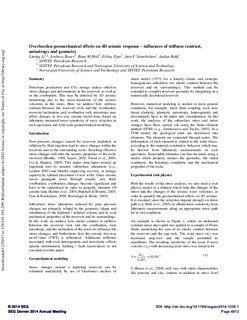| dc.contributor.author | Li, Liming | |
| dc.contributor.author | Bauer, Andreas | |
| dc.contributor.author | Holt, Rune Martin | |
| dc.contributor.author | Fjær, Erling | |
| dc.contributor.author | Stenebråten, Jørn | |
| dc.contributor.author | Bakk, Audun | |
| dc.date.accessioned | 2017-12-20T08:14:56Z | |
| dc.date.available | 2017-12-20T08:14:56Z | |
| dc.date.created | 2015-03-09T12:12:33Z | |
| dc.date.issued | 2014 | |
| dc.identifier.citation | SEG technical program expanded abstracts. 2014, 4913-4818. | nb_NO |
| dc.identifier.issn | 1949-4645 | |
| dc.identifier.uri | http://hdl.handle.net/11250/2473126 | |
| dc.description.abstract | Petroleum production and CO2 storage induce effective stress changes and deformations in the reservoir, as well as in the overburden. This may be detected by 4D seismic monitoring due to the stress-sensitivity of the seismic velocities in the rocks. Here we address how stiffness contrast between the reservoir rock and the overburden, reservoir inclination, and overburden rock anisotropy may affect changes in two-way seismic travel time, based on laboratory measured stress-sensitivity of wave velocities in rock specimens and field scale geomechanical modeling. | nb_NO |
| dc.language.iso | eng | nb_NO |
| dc.publisher | Society of Exploration Geophysicists | nb_NO |
| dc.title | Overburden geomechanical effects on 4D seismic response - influences of stiffness contrast, anisotropy, and geometry | nb_NO |
| dc.type | Journal article | nb_NO |
| dc.type | Peer reviewed | nb_NO |
| dc.description.version | publishedVersion | nb_NO |
| dc.source.pagenumber | 4913-4818 | nb_NO |
| dc.source.journal | SEG technical program expanded abstracts | nb_NO |
| dc.identifier.doi | 10.1190/segam2014-1530.1 | |
| dc.identifier.cristin | 1230458 | |
| dc.relation.project | Norges forskningsråd: 234074 | nb_NO |
| dc.description.localcode | © 2014 SEG | nb_NO |
| cristin.unitcode | 194,64,90,0 | |
| cristin.unitname | Institutt for geovitenskap og petroleum | |
| cristin.ispublished | true | |
| cristin.fulltext | preprint | |
| cristin.qualitycode | 1 | |
